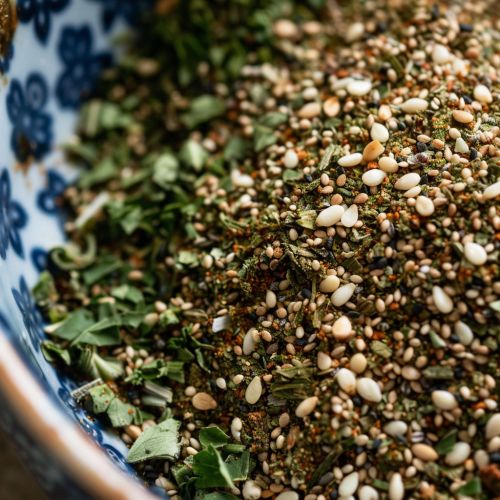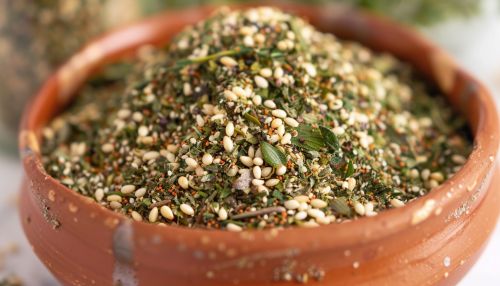Za'atar: Difference between revisions
(Created page with "== Introduction == '''Za'atar''' is a traditional Middle Eastern spice blend that has been used for centuries in various culinary applications. It is a staple in the cuisines of countries such as Lebanon, Syria, Jordan, and Palestine. The blend typically consists of dried thyme, oregano, marjoram, sumac, and toasted sesame seeds, though variations exist depending on regional and familial recipes. Za'atar is not only valued for its unique flavor profile but a...") |
No edit summary |
||
| Line 15: | Line 15: | ||
Other ingredients that may be included are [[salt]], [[cumin]], and [[coriander]]. | Other ingredients that may be included are [[salt]], [[cumin]], and [[coriander]]. | ||
[[Image:Detail-91297.jpg|thumb|center|A close-up image of a bowl of za'atar spice blend, showing the various herbs and sesame seeds.|class=only_on_mobile]] | |||
[[Image:Detail-91298.jpg|thumb|center|A close-up image of a bowl of za'atar spice blend, showing the various herbs and sesame seeds.|class=only_on_desktop]] | |||
== Historical Context == | == Historical Context == | ||
Latest revision as of 22:21, 21 June 2024
Introduction
Za'atar is a traditional Middle Eastern spice blend that has been used for centuries in various culinary applications. It is a staple in the cuisines of countries such as Lebanon, Syria, Jordan, and Palestine. The blend typically consists of dried thyme, oregano, marjoram, sumac, and toasted sesame seeds, though variations exist depending on regional and familial recipes. Za'atar is not only valued for its unique flavor profile but also for its purported health benefits and cultural significance.
Composition and Variations
The composition of za'atar can vary widely, but it generally includes the following components:
- **Thyme (Thymus vulgaris)**: This herb is a key ingredient in za'atar, providing a strong, earthy flavor. In some regions, wild thyme, known as za'atar in Arabic, is used.
- **Oregano (Origanum vulgare)**: Another essential herb, oregano adds a robust, slightly bitter taste.
- **Marjoram (Origanum majorana)**: Marjoram contributes a sweet, piney flavor to the blend.
- **Sumac (Rhus coriaria)**: This spice adds a tangy, lemony flavor and a reddish color to the mix.
- **Sesame Seeds (Sesamum indicum)**: Toasted sesame seeds add a nutty flavor and a crunchy texture.
Other ingredients that may be included are salt, cumin, and coriander.


Historical Context
Za'atar has a long history that dates back to ancient times. It is mentioned in historical texts and has been found in archaeological sites. The use of za'atar is believed to have originated in the Levant region, where it was used not only for culinary purposes but also for medicinal and religious practices. The ancient Egyptians, for example, used thyme in their embalming process, and it is believed that they also used za'atar as a preservative and flavoring agent.
Culinary Uses
Za'atar is incredibly versatile and can be used in a variety of dishes. It is commonly sprinkled on flatbreads such as manakish and pita, often with a drizzle of olive oil. It can also be used as a seasoning for meats, vegetables, and salads. In some cultures, za'atar is mixed with olive oil to create a paste that is spread on bread or used as a dip.
Manakish
Manakish is a popular Levantine dish that features za'atar as a primary ingredient. The dough is rolled out, topped with a mixture of za'atar and olive oil, and then baked until golden brown. This dish is often enjoyed for breakfast or as a snack.
Labneh
Labneh, a strained yogurt cheese, is often served with a sprinkle of za'atar and a drizzle of olive oil. This combination is a common breakfast item in Middle Eastern households.
Health Benefits
Za'atar is not only valued for its flavor but also for its health benefits. The herbs and spices in za'atar are rich in antioxidants, which can help reduce inflammation and protect against chronic diseases. Thyme and oregano, in particular, contain compounds such as thymol and carvacrol, which have antimicrobial properties. Sumac is known for its high vitamin C content and its ability to aid in digestion.
Cultural Significance
Za'atar holds a special place in Middle Eastern culture. It is often associated with hospitality and is a common offering to guests. In some cultures, za'atar is believed to have spiritual and protective properties. It is also a symbol of heritage and tradition, with recipes often passed down through generations.
Modern Adaptations
In recent years, za'atar has gained popularity outside of the Middle East. Chefs and home cooks around the world have begun to incorporate za'atar into a variety of dishes, from roasted vegetables to grilled meats. Its unique flavor profile makes it a versatile addition to many cuisines.
